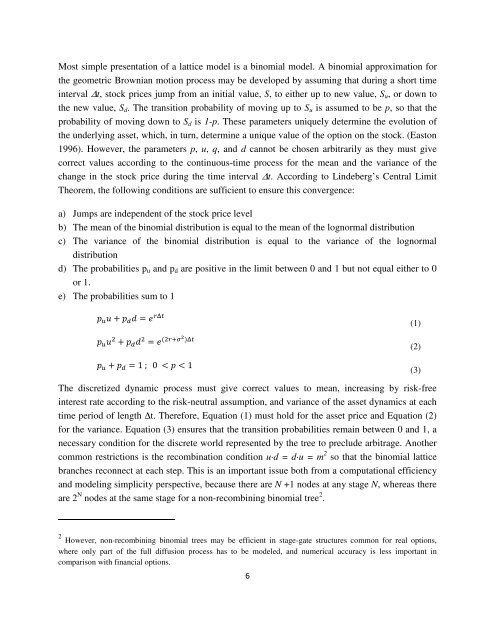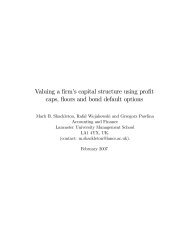Recombining Trinomial Tree for Real Option Valuation with ...
Recombining Trinomial Tree for Real Option Valuation with ...
Recombining Trinomial Tree for Real Option Valuation with ...
- No tags were found...
Create successful ePaper yourself
Turn your PDF publications into a flip-book with our unique Google optimized e-Paper software.
Most simple presentation of a lattice model is a binomial model. A binomial approximation <strong>for</strong>the geometric Brownian motion process may be developed by assuming that during a short timeinterval ∆t, stock prices jump from an initial value, S, to either up to new value, S u , or down tothe new value, S d . The transition probability of moving up to S u is assumed to be p, so that theprobability of moving down to S d is 1-p. These parameters uniquely determine the evolution ofthe underlying asset, which, in turn, determine a unique value of the option on the stock. (Easton1996). However, the parameters p, u, q, and d cannot be chosen arbitrarily as they must givecorrect values according to the continuous-time process <strong>for</strong> the mean and the variance of thechange in the stock price during the time interval ∆t. According to Lindeberg’s Central LimitTheorem, the following conditions are sufficient to ensure this convergence:a) Jumps are independent of the stock price levelb) The mean of the binomial distribution is equal to the mean of the lognormal distributionc) The variance of the binomial distribution is equal to the variance of the lognormaldistributiond) The probabilities p u and p d are positive in the limit between 0 and 1 but not equal either to 0or 1.e) The probabilities sum to 1 1 ; 0 1(1)(2)(3)The discretized dynamic process must give correct values to mean, increasing by risk-freeinterest rate according to the risk-neutral assumption, and variance of the asset dynamics at eachtime period of length ∆t. There<strong>for</strong>e, Equation (1) must hold <strong>for</strong> the asset price and Equation (2)<strong>for</strong> the variance. Equation (3) ensures that the transition probabilities remain between 0 and 1, anecessary condition <strong>for</strong> the discrete world represented by the tree to preclude arbitrage. Anothercommon restrictions is the recombination condition u·d = d·u = m 2 so that the binomial latticebranches reconnect at each step. This is an important issue both from a computational efficiencyand modeling simplicity perspective, because there are N +1 nodes at any stage N, whereas thereare 2 N nodes at the same stage <strong>for</strong> a non-recombining binomial tree 2 .2 However, non-recombining binomial trees may be efficient in stage-gate structures common <strong>for</strong> real options,where only part of the full diffusion process has to be modeled, and numerical accuracy is less important incomparison <strong>with</strong> financial options.6



